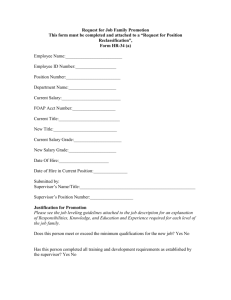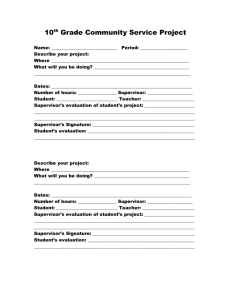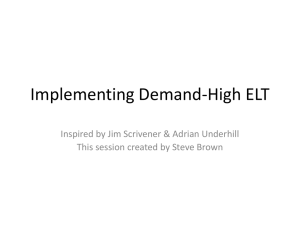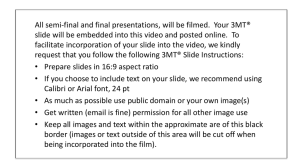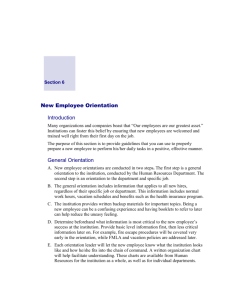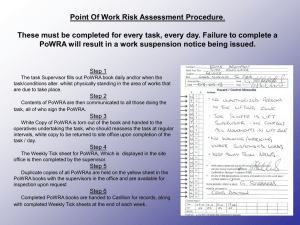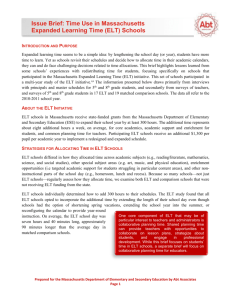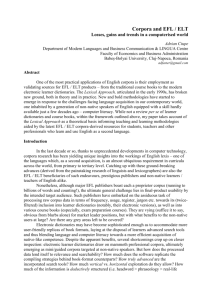ComputePixelColors32ARGBAlpha
advertisement
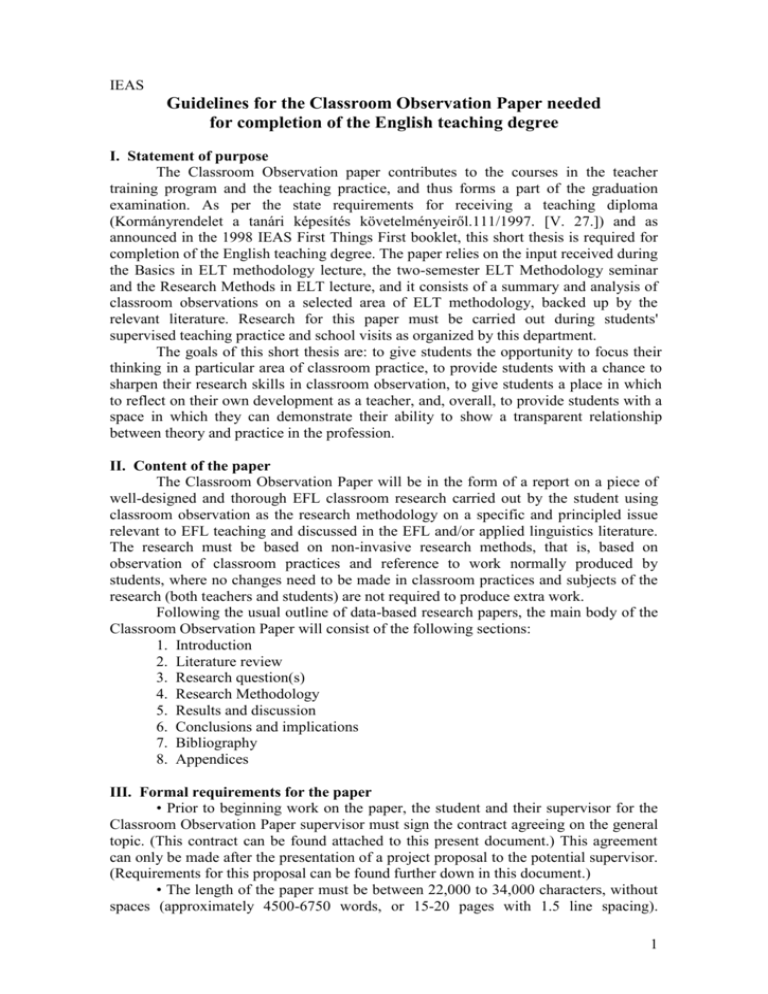
IEAS Guidelines for the Classroom Observation Paper needed for completion of the English teaching degree I. Statement of purpose The Classroom Observation paper contributes to the courses in the teacher training program and the teaching practice, and thus forms a part of the graduation examination. As per the state requirements for receiving a teaching diploma (Kormányrendelet a tanári képesítés követelményeiről.111/1997. [V. 27.]) and as announced in the 1998 IEAS First Things First booklet, this short thesis is required for completion of the English teaching degree. The paper relies on the input received during the Basics in ELT methodology lecture, the two-semester ELT Methodology seminar and the Research Methods in ELT lecture, and it consists of a summary and analysis of classroom observations on a selected area of ELT methodology, backed up by the relevant literature. Research for this paper must be carried out during students' supervised teaching practice and school visits as organized by this department. The goals of this short thesis are: to give students the opportunity to focus their thinking in a particular area of classroom practice, to provide students with a chance to sharpen their research skills in classroom observation, to give students a place in which to reflect on their own development as a teacher, and, overall, to provide students with a space in which they can demonstrate their ability to show a transparent relationship between theory and practice in the profession. II. Content of the paper The Classroom Observation Paper will be in the form of a report on a piece of well-designed and thorough EFL classroom research carried out by the student using classroom observation as the research methodology on a specific and principled issue relevant to EFL teaching and discussed in the EFL and/or applied linguistics literature. The research must be based on non-invasive research methods, that is, based on observation of classroom practices and reference to work normally produced by students, where no changes need to be made in classroom practices and subjects of the research (both teachers and students) are not required to produce extra work. Following the usual outline of data-based research papers, the main body of the Classroom Observation Paper will consist of the following sections: 1. Introduction 2. Literature review 3. Research question(s) 4. Research Methodology 5. Results and discussion 6. Conclusions and implications 7. Bibliography 8. Appendices III. Formal requirements for the paper • Prior to beginning work on the paper, the student and their supervisor for the Classroom Observation Paper supervisor must sign the contract agreeing on the general topic. (This contract can be found attached to this present document.) This agreement can only be made after the presentation of a project proposal to the potential supervisor. (Requirements for this proposal can be found further down in this document.) • The length of the paper must be between 22,000 to 34,000 characters, without spaces (approximately 4500-6750 words, or 15-20 pages with 1.5 line spacing). 1 Material outside the main body of the paper (that is, everything excluding 1-6 above mentioned in Section II) as well as long quotations, figures, graphs and charts are not contained in the character count. • The paper must follow the formatting rules set up in the IEAS Style Sheet for papers in linguistics. • The bibliography for the paper must contain at least seven items from the relevant literature. Each item must have been cited in the text. • A facsimile of each data collection instrument must be contained in the appendices. Furthermore, five completed examples of each data collection instrument also need to be included in the appendices. • Student must hand in with the final draft of their paper a form (which can be found attached to this present document) that indicates that the student has met the obligations in signing a contract with the supervisor and meeting deadlines for meetings. • Students must formally meet with their advisors three times during the course of the project. IV. Steps for completion of the paper For students graduating in the spring, the following steps/deadlines must be followed: 1. Find a general topic area and narrow it down to a specific issue within that topic. 2. Meet briefly with the supervisor to agree on a specific issue within a topic area. 3. Create a proposal for the research and hand it in to your advisor no later than October. (See section VI below for proposal guidelines.) 4. Meet with supervisor to discuss the details of the project and to sign the Classroom Observation Paper contract. 5. Carry out the research and write up the first complete draft. You must hand this in to your advisor no later than May. 6. Meet with supervisor to discuss the first draft. 7. Create the final draft of the paper, and hand it in with your thesis. V. Topics, issues and research questions for the paper • General topics for the classroom observation paper can come from the materials presented in the following courses: Introduction to EFL Methodology, the two 4th year methodology seminars, and Research Methods for Language Teachers. Furthermore, the methodology final exam (Záróvizsga) topic list can serve as a general guide for topics. Other topics can possibly come from applied linguistics courses in general. • Specific research questions directly come from narrowing down an issue in a general topic area. Research questions must be principled, that is they must directly follow from topics and issues raised in the literature. All research questions must be descriptive and not evaluative. That is, research questions must not attempt to determine what is "best" or "good" or "bad" in a particular language classroom, but must simply describe what happens in a classroom concerning a specific topic and issue. (This, of course, does not exclude the possibility of evaluation of the data in the results and discussion, and conclusions and implications sections of the paper.) As an example, consider the following topic, issue and research question as discussed in the Research Methods for Language Teachers course: General topic area — classroom interaction and input Specific issue — the relationship between interaction, input and proficiency 2 Research question — Are students who participate more in a language class at a higher proficiency level than those who participate less? Consider the second example which comes from topics and issues discussed in all of the required methodology courses: General topic area — error correction Specific issue — techniques used by teachers to correct errors Research questions — 1) Which techniques are most commonly used by teachers to correct errors; and 2) do students respond differently to different types of error correction? • Good resources for finding specific topics and issues and developing specific research questions are, but aren't limited to, the following: notes from required methodology courses; required readings from methodology courses including the source books themselves that these readings come from; general methodology books, guides to classroom research, and books on second language acquisition; and journals on English language teaching, such as: ELT Journal, TESOL Quarterly, and NovELTty. VI. Contents of the paper proposal The more specific and detailed your research proposal is, the easier it will be for your advisor to help you with your project. Therefore, the paper proposal must be organized around the sections noted below. This format must be followed for the proposal to be considered. 1. Background. Here, like in a literature review, you briefly present, contextualize, and justify the importance of the general topic area and issue you would like to do research on. This section should make reference to published sources on the topic and any specific studies which have previously been carried out. 2. Research question(s). These questions should be stated as formal research questions. 3. Research methods. Here you need to describe the observation instrument(s) which you propose using to collect your data. The use of previously used instruments from published sources is highly encouraged and should be described here. 4. Comments. In this section you can address your paper advisor with specific questions or concerns you have about this specific topic, or address other relevant issues. 4. Bibliography. Be sure to include the complete bibliographic references for any source you cite in the previous three points. 5. Appendices. If you plan to use a previously published observation instrument or have a draft copy or your own, this is the place to include it. 3 VII. Assessment criteria • Each paper will be assessed by two readers using the following scale: ASPECT POINTS Concept & research design: Use of appropriate research instruments; 0-1-2-3-4-5 appropriateness, clarity and sophistication of research questions; feasibility of the project. Argumentation and analysis: development of the issue in the literature 0-1-2-3-4-5 review; treatment the problem; quality and coherence of the analysis and discussion of the data; conclusions drawn; demonstrated relationship between theory and practice. Language and format: clarity and accuracy of expression; organization 0-1-2-3-4-5 on the paragraph and section level; application of formatting rules as shown in the IEAS Style Sheet. Fraction (half) points are not allowed. • Students will be required to make a short presentation of their project and answer brief questions on it which arise during the methodology exam. This performance will be marked and be figured into the final calculations for a mark in methodology which will include, the grade on their paper, the final exam grade and the presentation of the classroom observation project. 4
